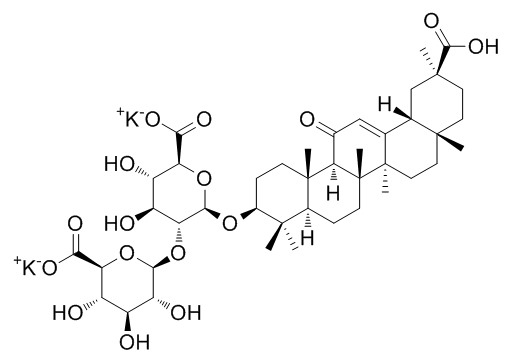Dipotassium Glycyrrhizinate
Dipotassium glycyrrhizinate is an anionic surfactant having anti-allergic and anti-inflammatory activities.
Inquire / Order:
manager@chemfaces.com
Technical Inquiries:
service@chemfaces.com
Tel:
+86-27-84237783
Fax:
+86-27-84254680
Address:
1 Building, No. 83, CheCheng Rd., Wuhan Economic and Technological Development Zone, Wuhan, Hubei 430056, PRC
Providing storage is as stated on the product vial and the vial is kept tightly sealed, the product can be stored for up to
24 months(2-8C).
Wherever possible, you should prepare and use solutions on the same day. However, if you need to make up stock solutions in advance, we recommend that you store the solution as aliquots in tightly sealed vials at -20C. Generally, these will be useable for up to two weeks. Before use, and prior to opening the vial we recommend that you allow your product to equilibrate to room temperature for at least 1 hour.
Need more advice on solubility, usage and handling? Please email to: service@chemfaces.com
The packaging of the product may have turned upside down during transportation, resulting in the natural compounds adhering to the neck or cap of the vial. take the vial out of its packaging and gently shake to let the compounds fall to the bottom of the vial. for liquid products, centrifuge at 200-500 RPM to gather the liquid at the bottom of the vial. try to avoid loss or contamination during handling.
Biomed Pharmacother.2022, 145:112410.
Int. J. Mol. Sci.2023, 24(20),15294.
Anal Bioanal Chem.2018, 410(5):1561-1569
Int J Mol Sci.2024, 25(20):11227.
ACS Nano.2023, 17(11):9972-9986.
J Agric Food Chem.2021, 69(11):3496-3510.
Int J Cosmet Sci.2023, 45(2):155-165.
Korean J of Pharmacognosy2020, 51,49-54.
Front Pharmacol. 2024, 15:1527494.
Front Pharmacol.2020, 11:566490.
Related and Featured Products
Int J Pharm. 2002 Jul 25;241(2):319-27.
Elastic liposomes for skin delivery of dipotassium glycyrrhizinate.[Pubmed:
12100859]
The aim of this study was to evaluate the possibility of using liposomes for skin delivery of Dipotassium Glycyrrhizinate (KG), an anti-inflammatory agent employed in treating acute and chronic dermatitis, and of formulating such liposomes in an oil-in-water emulsion (O/W). KG had emulsifying properties and the possibility of producing elastic liposomes was verified.
METHODS AND RESULTS:
Liposomes containing soya lecithin (PC) or hydrogenated soya lecithin (HPC) mixed with KG in w/w ratios of 2:1, 4:1 or 8:1 were prepared by the solvent evaporation method and then passed through a high pressure homogeniser. Liposome size and entrapment efficiency were determined and the interaction between KG and HPC was investigated using differential scanning calorimetry (DSC). Transepidermal permeation through intact pig skin and skin deposition of KG from liposomes and O/W emulsion containing liposomes were assessed and compared with values for aqueous control solutions. No marked differences were observed between PC and HPC liposomes. Liposome sizes ranged from 90 to 120 nm. Entrapment efficiency depended on the lipid:KG ratio; the maximum efficiency was obtained at 4:1 w/w. KG interacted with liposomes disrupting and fluidising the lipid bilayer, forming elastic liposomes able to penetrate through membrane pores of diameter much smaller than their own diameter.
The liposome structure was maintained when dispersed in an O/W emulsion.
CONCLUSIONS:
The skin fluxes were less than the HPLC detection limit for all systems, while skin deposition increased 4.5-fold compared with aqueous solutions when KG was formulated in liposomes.



